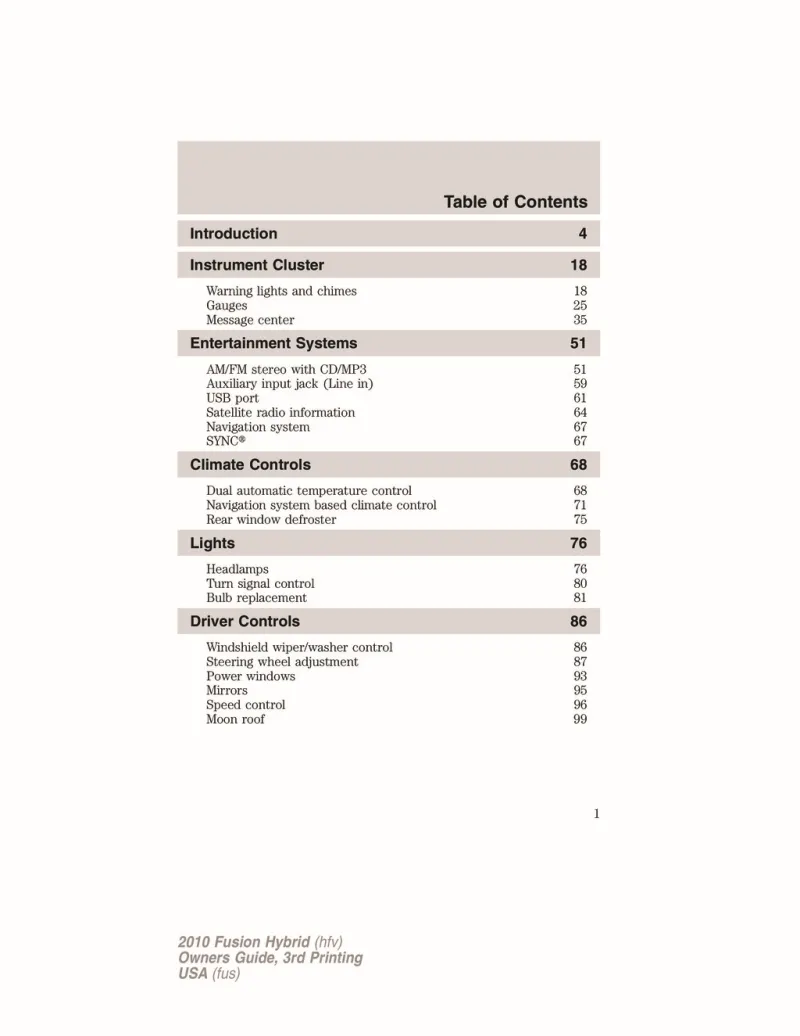2010 Ford Fusion Hybrid Owner's Manual

Table of Contents
2010 Ford Fusion Hybrid Overview
Introduction
The 2010 Ford Fusion Hybrid stands as a remarkable example of efficient hybrid technology combined with Ford's sleek, modern design. This midsize sedan balances environmental responsibility with the driving experience, making it an ideal choice for eco-conscious consumers who refuse to compromise on performance or style. With its smooth handling and impressive fuel efficiency, the Fusion Hybrid offers an exceptional driving experience, suitable for both city cruising and highway travel.
Powertrains
At the heart of the 2010 Fusion Hybrid lies a sophisticated powertrain that pairs a 2.5-liter four-cylinder gasoline engine with an electric motor. Together, they produce a combined output of approximately 191 horsepower. The seamless integration of this hybrid system allows the Fusion to achieve impressive fuel economy ratings of up to 41 mpg in the city and 36 mpg on the highway. This powertrain not only emphasizes efficiency but also ensures a responsive and engaging driving feel, making the Fusion Hybrid a pleasure to drive.
Trims
The 2010 Fusion Hybrid is offered in a single well-equipped trim that includes an extensive array of standard features. This trim is designed to provide all the essentials and comfort necessary for the modern driver. Various optional packages are available to allow owners to customize their experience further, ensuring that the Fusion meets a wide range of needs and preferences.
Features
Inside the Fusion Hybrid, you'll find a wealth of technology and creature comforts, including a premium audio system, Bluetooth connectivity, and an easy-to-use touchscreen interface. Safety is paramount, with standard features such as multiple airbags, stability control, and anti-lock brakes. Additionally, the Fusion Hybrid comes equipped with a unique SmartGauge instrument cluster that provides real-time feedback on driving efficiency, allowing owners to optimize their driving habits.
Owner's Manual
The owner's manual for the 2010 Ford Fusion Hybrid serves as a comprehensive guide for enhancing your ownership experience. It contains vital information on vehicle operation, maintenance schedules, and troubleshooting tips to help keep your hybrid running smoothly. Whether you're a seasoned driver or new to hybrid technology, the owner’s manual is an invaluable resource for getting the most out of your Fusion Hybrid.
User manual download
The Ford Fusion Hybrid owner manual for the 2010 model year is to be found in PDF downloadable format on this page. The owner manual for the model year 2010 is free and in English, but the repair manuals are usually not easy to get and may cost more.
Manual Questions
Fill the form below and someone will help you!

